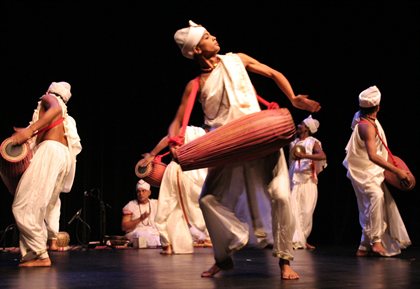Performance and transmission in the Garden of Assam
Dance, textile and display: From India's Northeast to the British Museum
The dance
In Assam, a state in the northeast of India, over the past four hundred years, a beautiful classical dance has been cultivated by monks who inhabit the island of Majuli. Little known in the rest of India and unheard of in Europe, 'Sattriya Dance' has only just begun to gain recognition beyond Assam. In 2000, it was formally recognised as an Indian Classical Dance form. In 2016, monastic performers from Majuli Island will travel to England for the very first performance of sattriya by its original practitioners.
The tapestry
The British Museum has owned the stunning nine-metre 17th-century tapestry, known as the Vrindavani Vastra, for more than a hundred years. From January to August 2016, this extraordinary Assamese textile is on display as the centre piece of an exhibition on India's northeast region. The tapestry depicts stories from the life of the important Hindu God, Lord Krishna. It shows figures dancing Sattriya dance and contains extracts from the traditional dance dramas of Assam.
The event
On 8 July 2016, scholars, dancers and members of the public who were interested in this under-researched region of India gathered in the British Museum. From 10.00 to 18.00, ten scholars and speakers from India, the US, Germany and the UK presented papers related to northeastern India/ Eastern Himalayan culture and will discuss common research interests. Monastic performers from Assam, India took part in the discussions through dance demonstrations and explanation in English. From 18.00 to 20.00 they presented a public performance of Sattriya Dance, including a specially curated dance response to the textile itself, followed by a Q&A with the public.

Objectives of the project
Participants in this day-long event addressed the following questions:
- What is the current state of the monastic arts and dances in the northeast of India?
- How have these arts been represented by scholars, curators and other commentators?
- Does dance and music belong in a museum?
- What is the Vrindavani Vastra doing in the British Museum?
Intended outputs
As well as the public performance, this project should lead to an edited volume, or special edition journal of papers from the conference surrounding questions of dance and representation, and/or an ‘Object in Focus’ British Museum Publication on the Vrindavani Vastra.
‘Performance and transmission in the Garden of Assam’ is a collaboration between King's College London's Department of Music and the British Museum. It was supported by the university's Culture team.
This project is part of the Early Career Researchers scheme. Georgina Pope, PhD student in the Department of Music, has been mentored by Saoirse O'Toole, Knowledge Exchange Associate for the Dental Institute.